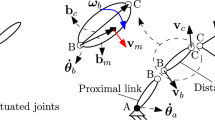Abstract
This paper provides stability analysis of a robust interaction control, nonlinear bang–bang impact control, for one degree-of-freedom robot manipulators. The interaction controller takes advantages of robot joint’s friction that is not helpful for constrained space control usually, has no need to change gains throughout the tasks requiring free space motion, constrained motion, and the transition between the two, and needs virtually no information on robot dynamics for its design and implementation. Despite these advantages, to date, there was no complete and formal proof of its stability, hindering its practical use for interaction tasks requiring robots’ frequent contact with various environments, including humans. A sufficient stability condition was derived based on the L∞ space analysis with its physical implications. Stability condition was found to be only dependent on the intentional time delay for the online lumped robot dynamics estimation and the inertia estimation accuracy and was not dependent on the passive environment properties and disturbances. Interestingly, in the case of the nonlinear bang–bang impact control, joint frictions helped stabilize the robot during the transition from free space to constrained space.


Similar content being viewed by others
Notes
\( \delta_{a} (t) = \left\{ {\begin{array}{*{20}l} {\frac{1}{2a}} \hfill & { - a \le t \le a} \hfill \\ 0 \hfill & {t < - a{\text{ or }}t > a} \hfill \\ \end{array} } \right. \)
References
Lee E, Park J, Loparo KA, Schrader CB, Chang PH (2003) Bang-bang impact control using hybrid impedance/time-delay control. IEEE/ASME Trans Mechatron 8(2):272–277. https://doi.org/10.1109/TMECH.2003.812849
Kang SH, Jin M, Chang PH, Lee E (2005) Nonlinear bang-bang impact control for free space, impact and constrained motion: multi-DOF case. In: Proceedings of the American control conference, Portland (OR), USA, 8–10 June 2005, vol 1913, pp 1913–1920. https://doi.org/10.1109/acc.2005.1470248
Jin M, Kang SH, Chang PH, Lee E (2005) Nonlinear Bang–Bang impact control: a seamless control in all contact modes. In: Proceedings of the IEEE international conference on robotics and automation, Barcelona, Spain, 18-22 April 2005, pp 557–564. https://doi.org/10.1109/robot.2005.1570177
Youcef-Toumi K, Ito O (1990) A time delay controller for systems with unknown dynamics. ASME J Dyn Syst Meas Control 112(1):133–142. https://doi.org/10.1115/1.2894130
Gilardi G, Sharf I (2002) Literature survey of contact dynamics modelling. Mech Mach Theory 37(10):1213–1239. https://doi.org/10.1016/S0094-114X(02)00045-9
Hsia TC, Gao LS (1990) Robot manipulator control using decentralized linear time-invariant time-delayed joint controllers. In: Proceedings of the IEEE international conference on robotics and automation, Cincinnati (OH), USA, vol. 2073, pp 2070–2075. https://doi.org/10.1109/robot.1990.126310
Spong M, Vidyasagar M (1987) Robust linear compensator design for nonlinear robotic control. IEEE J Robot Autom 3(4):345–351. https://doi.org/10.1109/JRA.1987.1087110
Khalil HK, Grizzle JW (2002) Nonlinear systems, vol 3. Prentice hall Upper Saddle River, NJ
Ortega R, Spong MW (1989) Adaptive motion control of rigid robots: a tutorial. Automatica 25(6):877–888. https://doi.org/10.1016/0005-1098(89)90054-X
Vukobratović MK, Potkonjak V (1999) Dynamics of contact tasks in robotics. Part I: general model of robot interacting with environment. Mech Mach Theory 34(6):923–942. https://doi.org/10.1016/S0094-114X(97)00091-8
Pagilla PR, Biao Y (2001) A stable transition controller for constrained robots. IEEE/ASME Trans Mechatron 6(1):65–74. https://doi.org/10.1109/3516.914393
Lee E, Chang P-H, Park J, Schrader CB (2003) Hybrid impedance/time-delay control from free space to constrained motion. In: Proceedings of the American Control Conference, 4–6 June 2003, vol 2133, pp 2132–2137. https://doi.org/10.1109/acc.2003.1243389
Lee E (1994) Force and impact control for robot manipulators with unknown dynamics and disturbances. Ph.D. Dissertation, Case Western Reserve University, Cleveland, OH
Lee E (1999) Force and impact control for robot manipulators using time delay. In: ISIE’99. Proceedings of the IEEE international symposium on industrial electronics, Bled, Slovenia, 12–16 July 1999, vol 151, pp 151–156. https://doi.org/10.1109/isie.1999.801775
Acknowledgements
This work was supported partly by Basic Science Research Program through the National Research Foundation of Korea (NRF) funded by the Ministry of Education (2018R1D1A1B07049862), and partly by the Translational Research Program for Rehabilitation Robots (NRCTR-EX19004), National Rehabilitation Center, Ministry of Health and Welfare, Korea.
Author information
Authors and Affiliations
Corresponding author
Additional information
Publisher's Note
Springer Nature remains neutral with regard to jurisdictional claims in published maps and institutional affiliations.
Rights and permissions
About this article
Cite this article
Kang, H., Lee, S.J. & Kang, S.H. Stability of a robust interaction control for single-degree-of-freedom robots with unstructured environments. Intel Serv Robotics 13, 393–401 (2020). https://doi.org/10.1007/s11370-020-00323-w
Received:
Accepted:
Published:
Issue Date:
DOI: https://doi.org/10.1007/s11370-020-00323-w




